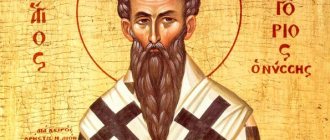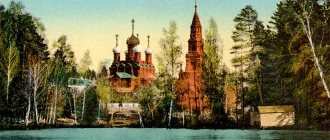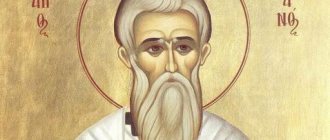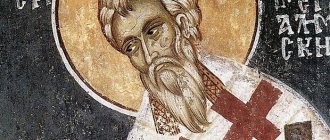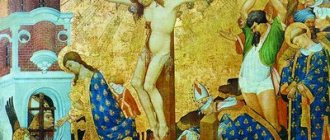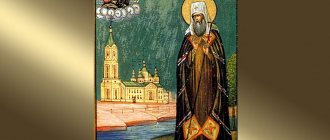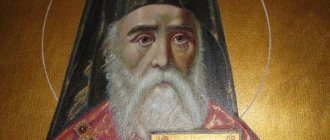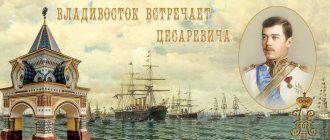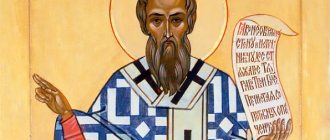| Ep. Vasily (Preobrazhensky) |
Vasily (Preobrazhensky)
(1876 - 1945), Bishop of Kineshem, holy confessor Memory of July 31, October 5 on the day of the discovery of the relics, in the Cathedrals of Voronezh and Poltava (Ukr.) Saints
In the world, Veniamin Sergeevich Preobrazhensky, was born on January 7, 1876 in the city of Kineshma, Kostroma province, in the family of the priest Sergius and his wife Pavla, and owed his Christian upbringing entirely to his parents. The whole structure of life that surrounded the boy from childhood was similar to that of a monk. No news, no gossip, no idle talk penetrated the high fence of their house, which the children were forbidden to leave. It was a joy for the child to visit their home with poor brethren and wanderers. On the very day of his baptism, when Benjamin was brought home from the temple, an old wanderer came to them, who, looking at the boy, said: “This will be a great man.” There were other omens of his extraordinary future.
Education and teaching career
After graduating from high school, he entered the Kineshma Theological School, which he graduated in 1890. In 1896, he graduated from the Kostroma Theological Seminary as the first student [1] and entered the Kiev Theological Academy, from which he graduated in 1900 with a candidate of theology degree and the right to receive a master's degree in theology without a new oral revision test, according to the instructions of the reviewers [2].
In 1900 he was appointed caretaker of the Alexander Nevsky Theological School in St. Petersburg.
In 1901, he was appointed teacher of accusatory theology, history and exposure of the Russian schism and local sects at the Voronezh Theological Seminary; At the same time he taught at a men's Sunday school and the Voronezh diocesan women's school. Since 1901 - full member of the Voronezh provincial scientific archival commission. He stayed in Voronezh until 1910.
Knowing both ancient and new European languages perfectly, he went to England for a more in-depth study of European culture and lived in London in 1910-1911. Upon returning to Russia, in 1911-1914 he taught foreign languages and general history at the Mirgorod men's gymnasium.
On January 20, 1912, he defended his master’s thesis at the KDA “Slavic-Russian Skete Patericon. Experience in historical and bibliographic research" and received a master's degree in theology.
In 1914 he moved to Moscow and got a job as a Latin teacher at the Petrovskaya Gymnasium. Teaching fascinated him so much that he graduated from the Pedagogical Institute. P. G. Shelaputin, having finally prepared for the profession of a teacher. But the Lord decreed otherwise.
One day, when he came to visit his parents in Kineshma, Veniamin persuaded his friends to go boating on the Volga. Already far from the shore, the boat suddenly capsized. Benjamin prayed, asking the Lord to save his life, promising to devote himself to serving the Orthodox Church. At that moment he saw a thick long board and, grabbing onto it, swam out.
Church service in Kineshma
Soon after this incident, Veniamin returned to Kineshma, and in October 1917 he became a psalm-reader in the Church of the Ascension, where his elderly father served. Remembering his vow to God, he began to preach in the churches of Kineshma and its environs. Realizing that without an accurate and deep understanding of the Holy Scriptures, an ignorant person could easily become the prey of deceivers and false teachers, Benjamin began to create Orthodox circles where great importance was attached to the study of the Holy Scriptures.
On July 16, 1920, he was ordained to the priesthood in the city of Kostroma by Metropolitan Seraphim (Meshcheryakov). Soon after this, his father, Archpriest Sergius, died, and Father Benjamin took monastic vows in honor of Basil the Great.
On September 19, 1921, he was consecrated Bishop of Kineshma, vicar of the Kostroma diocese. The ordination took place in the Assumption Cathedral of Kineshma.
Refusing any property, he settled on the outskirts of the city in a small bathhouse that stood in the garden of the widow-soldier Anna Alexandrovna Rodina. The saint did not have any property or furnishings; he slept on the bare floor, putting a log under his head. He hid his feat from strangers, receiving visitors in the office, set up in a house next to the Church of the Ascension. There was a bathhouse far from the temple. Every morning, before dawn, Vladyka walked through the entire city to the temple and returned home late at night. More than once robbers stopped him on the street, and with meekness and love he gave them everything he had; they soon began to recognize him and did not bother him.
In addition to daily church services, during which he always preached, the saint confessed, went around the houses of everyone who needed his help with words of consolation, visited monasteries and circles founded by him, scattered throughout the diocese.
On major holidays, the saint served in the cathedral, and every Thursday he held all-night vigils in the Church of the Ascension. The people loved these all-night vigils, dedicated to the remembrance of the passion of the Lord, and gathered at them in large numbers. There were especially many workers, some of them lived in the outskirts of the city, they stood for long service and only got home late at night, and in the morning they went to work again, but the grace of church prayer was so great that people did not feel tired. The saint himself read the akathist to the passion of the Lord, and there was such silence in the temple, as if there was not a single person in it, and at the very far end of it every word could be heard.
Bishop Vasily's sermons attracted more and more people to the church. Some completely changed their lifestyle; others, following the example of the saint, distributed property to the poor, devoting their lives to serving the Lord and their neighbors. The light of faith also reached non-believers. No matter how another person felt about the Christian faith and the Orthodox Church, almost everyone felt that the word spoken by the bishop answered the inner needs of the soul, returned life to it, and illuminating meaning to life.
The bishop's missionary activity caused great concern among the authorities. But there was no reason to arrest the saint. And then the authorities began to send people to the temple, instructing them to ask tempting questions during the bishop’s sermon in order to confuse him. The Bishop foresaw that there were such people in the temple, and gave answers to many of their questions in advance. Convicted by their conscience, realizing how unprofitable their situation was, they left the temple without asking anything.
As a true shepherd, the saint protected his flock from all kinds of evil and error. If he found out that one of his spiritual children was thinking wrongly, he hurried to visit this person.
In March 1921, he was arrested and held as a hostage by the Ivanovo-Voznesensk Cheka during the Kronstadt uprising.
In the summer of 1922, a renovationist schism arose. In those parishes where the church was captured by the renovationists, the saint blessed the priests not to leave their flock, but to celebrate the liturgy in the village squares. He himself set an example of such service, and hundreds and thousands of people came to these services.
In 1922, famine broke out in the Lower Volga region, from which thousands of people died every day. The authorities ordered the selection of children left without parents and sent them to orphanages in different cities. Shortly before Easter, these children were brought to Kineshma. Having learned about this, the saint, after the service, addressed the people with a sermon, calling on them to help the starving. After her, many took children into their families.
Moves, exiles, conclusions
On March 4, 1923, he was appointed Bishop of Ivanovo-Voznesensk, but was unable to arrive at the see. On May 10, 1923, he was arrested and exiled to the Zyryansky region, in the village of Ust-Kulom, for two years. Soon Vladyka Vasily’s cell attendant, Alexander Chumakov, arrived here, voluntarily sharing with him the hardships of exile.
In May 1925, the exile ended, and Bishop Vasily returned to Kineshma. He informed the spiritual children about his return, and they began, gathering in small groups, to come to him at the Ascension Church; here after the evening service he confessed. The confession lasted for a long time, until late at night, and many unresolved questions accumulated.
At Christmas 1926, the authorities, concerned about the growth and strengthening of the Church, demanded that the bishop leave the city. Alexander Pavlovich offered to go to his homeland, to the village of Anapol, to wait out the difficult time there. The Bishop agreed.
In two weeks, Alexander Pavlovich built a small house. A throne was installed in the house and daily statutory services were held. The bishop and Alexander Pavlovich served alone; no outsiders were present at their services, since there was an Orthodox church nearby, where a priest close to the saint served, for whom Alexander Pavlovich had once been a psalm-reader.
So, in almost complete solitude, the bishop lived for about six months, and then went to Sarov to pray for the last time at the relics of St. Seraphim; was in Diveevo, from there he went to Nizhny Novgorod, where, together with the deputy patriarchal locum tenens, Metropolitan Sergius (Stragorodsky) and Bishop Hieromartyr Alexander (Shchukin), he participated in the consecration of Hieromonk Nicholas (Golubev) as Bishop of Vetluzh. Metropolitan Sergius informed Bishop Vasily about the transfer of Bishop Korniliy (Sobolev) of Vyaznikovsky to the Yekaterinburg See and that the Vyaznikovites were asking him to join them. “However,” he added, “you will be considered Kineshemsky, the Vyaznikovsky department will be temporary for you.” The saint accepted this appointment.
In Vyazniki the bishop continued the work begun in Anapol. For a long time he wanted to collect the conversations he had in church and in circles into one book. He handed over the manuscript of the book to trusted people in Kineshma, and they copied it by hand.
At the beginning of 1927, Bishop Afanasy (Sakharov) sent his cell attendant Hieromonk Damaskin (Zhabinsky) to Vladyka in Vyazniki with a note asking whether Bishop Vasily would accept temporary administration of the Vladimir diocese in view of the fact that he, Bishop Afanasy, had been arrested and could not continue serving. At that time, Metropolitan Sergius (Stragorodsky) was arrested, and Archbishop Hieromartyr Seraphim (Samoilovich) took over the administration of the Russian Orthodox Church. Bishop Vasily turned to him to resolve this issue, but Bishop Seraphim sent Bishop Damian (Voskresensky) to Vladimir, and appointed Saint Basil to the Ivanovo See. But there was no need to take advantage of the appointment. By this time, the saint’s sermons and his spiritual steadfastness began to attract many people to the temple and the authorities sent the bishop back to Kineshma. Here he served for several months when the authorities demanded that he leave.
In June 1927, Bishop Vasily came to Kostroma, where he lived for about a year. His main concern was spiritual children; he wanted to know everything about each one and did not miss an opportunity to instruct and spiritually support each of them. Correspondence with them took a lot of time and could not be entrusted to the post office. The bishop gave the letters to his subdeacon Vasily Smirnov, who took them to Ekaterina Knishek, and she already distributed them to their recipients, in turn collecting letters to the bishop.
In 1928, the bishop went to Yaroslavl to talk with the confessor, Metropolitan Agafangel, on issues of church life. He met him in the temple, where he had come to pray. The Metropolitan invited Bishop Vasily to remain in Yaroslavl as a suffragan bishop, but he refused.
In August of this year, the bishop returned to Kineshma and a month later was arrested. Bishop Vasily spent about six months in Ivanovo prison and was sentenced to three years of exile.
The bishop went into exile in a prison convoy. The saint settled in the small taiga village of Malorechka, twenty-five kilometers from the regional town of Taborovo, Yekaterinburg region. Alexander Pavlovich shared with him the difficulties of exile here too. Together they set up a throne in the house, the bishop consecrated it and performed divine services every day.
Prayer, hard work in the forest - life was like a monastery with the most severe rules. Alexander Pavlovich earned money by fishing and making wooden troughs. They spoke to each other little and rarely. Sometimes the hour of rest came, and they went into the forest. Three years passed in solitude, prayer and work, and the fourth was already ending. The bishop's thoughts were inclined to remain here forever. But it turned out that the link cannot be chosen freely. Just as he was about to ask the local authorities for permission to stay, they themselves began to demand that he leave.
Thinking about which place to choose as a place of exile, the bishop turned to Alexander Pavlovich, whose stories about Optina Pustyn he loved to listen to:
- What about the baker Photius, whom you helped in Optina, where you were from?
- From Orel.
- Well, that’s good, let’s go to the homeland of Photius.
The bishop arrived in Orel in September 1932. Immediately, nun Vitalia came to him from Kineshma and brought many letters. To some he wrote the answers himself, to others he gave answers orally, so that they would write them down and pass them on. Until December, the bishop lived alone, because Alexander Pavlovich lingered in the Urals, waiting for the winter route to be established in order to take things out of the taiga wilderness.
In the village of Navoloki, where the bishop had a circle, the church was captured by renovationists, and the Orthodox - primarily the spiritual children of the bishop - began to go to the church in the village of Semigorye, where priest Pavel Nikanorovich Berezin, an admirer of Bishop Vasily, served. Observing the revival of church life in Semigorye, in December 1932 the GPU arrested Father Paul and Deacon Vasily Mager, and many were summoned for interrogation.
| Bishop Vasily Kineshemsky, prison photo, 1933 |
In March 1933, the bishop received news that his spiritual children were being interrogated in Kineshma, some had already been arrested, and investigators were asking about the bishop.
On March 31, Bishop Vasily and Alexander Pavlovich were summoned to the Oryol vocational school, arrested and sent to the Kinesha prison. The Bishop was accused of:
«being an opponent of the Soviet regime, focusing on the restoration of state power, in 1918 he created a network of counter-revolutionary circles - a branch of the TOC (True Orthodox Church), which set as its task, through the religious anti-Soviet education of the religious masses, the overthrow of the existing system... Organized and trained cadres of secret prayer monasticism... Achieved in in a number of village councils of the Kineshma region, the decline in the growth of collectivization, mass unrest and the departure of old women workers from production
».
In July 1933, Bishop Vasily was sentenced to five years in a forced labor camp. Together with him, eleven people were sentenced, in particular the priest Pavel Berezin, Alexander Chumakov and the nun Vitaly - to five years, Maria Andreevna Dmitrova and her sister Elizaveta - to three years in the camps.
The bishop served his imprisonment near Rybinsk during the construction of a canal.
In January 1938, the bishop was released from the Rybinsk camp. He settled in Rybinsk with a landlady who provided him with a separate room. In the camp, Vladyka met the priest of the village of Arkhangelsk, Uglich region, Father Sergius Yaroslavsky, who, after his release, began to serve in Uglich, and Vladyka often visited him. On one of his visits to Uglich, the bishop met the regent of the church in the village of Kotovo, Iraida Osipovna Tikhova, and she invited him to live with her in Kotovo.
Having moved to the village of Kotovo, Vladyka agreed with the local priest Konstantin Sokolov to serve together all-night vigil and liturgy on weekdays in the presence of only his closest people; Later, in the garden of the owner of the house, in the bathhouse, a small temple was built.
On November 5, 1943, Bishop Vasily was arrested by the Yaroslavl NKGB and on November 7 imprisoned in the Yaroslavl internal prison. The bishop's confiscated property turned out to be little: one old cassock, a wooden cross, an icon, a children's toy, a leather belt and a comb. Upon admission to the prison, the doctor diagnosed myocarditis and recommended light work. Vladyka was sixty-eight years old.
From the next day, interrogations began - the bishop was interrogated, not allowing him to sleep for many days. This investigative conveyor belt, torture by hunger against the backdrop of the infirmities and diseases of old age, broke the will to resist investigative speculation. And when the investigator once again brought the interrogation report typed ahead of time, the bishop signed it; he decided to speak at least somehow, to explain at least something. He talked for a long time about his religious path. How he was in England before the revolution and watched the Christian student movement there with interest, how he returned to Russia and here he himself became a member of the Moscow student circle. How he later created “evangelical circles” and how he reacted completely negatively to the October revolution. For some time he thought that as a result of the law on the separation of the Church and the state, it would gain freedom from state violence, but soon the state opened the most severe persecution of the Church, and then he left for Kineshma to visit his father.
The investigator wrote down in his own way:
«Having united around himself people dissatisfied with the Soviet regime from among supporters of the illegal church living in the cities and districts of the Ivanovo and Yaroslavl regions, he created an anti-Soviet organization and led it until the moment of his arrest, nurturing the hope that a change in the political system in our country would be inevitable...
»
In January 1944, the NKGB of the USSR telegraphed to Yaroslavl so that Bishop Vasily would be transported to Moscow to an internal prison.
Exhausted by his two-month stay in the Yaroslavl prison and interrogations, the saint was brought to Moscow barely alive. Upon admission to the internal prison of the NKGB on January 26, the doctor diagnosed: myocarditis, arteriosclerosis, exhaustion and wrote out a referral to the hospital.
At the end of January, the bishop was sent to the Butyrka prison hospital. But he didn't stay here long. Two weeks later he was transferred to the internal prison of the NKGB for interrogation. State Security Major Polyansky interrogated Vladyka. Bishop Vasily was included in the same “case” with Bishop Afanasy (Sakharov), who was also taken to Moscow. On July 13, the bishop was transferred to Butyrka prison and the sentence was announced: five years of exile, after which the bishop suffered a severe heart attack.
In the general stage, he was sent to the prison of the city of Krasnoyarsk, where he was told that he must follow himself to the place of exile in the village of Birilyussy. The bishop had nothing except a cassock, an icon, and a cross; he found a tiny piece of paper and wrote a statement to the Krasnoyarsk NKGB, so that from the money taken during the arrest, he would be given at least a hundred rubles for the initial establishment.
The bishop found himself in a remote Siberian village. The morals of the youth were corrupted by godlessness and hardened by the war; even children were driven wild by cruelty. For a long time the bishop could not find an apartment for himself and finally settled in the house of a widow who had three young children. When the bishop prayed, they rolled balls from horse dung and threw them at the saint with the words: “Here, grandfather, eat.”
Soon the Lord gave him some relief: believing women found him another apartment. The owner was lonely, and at that time an exiled nun lived with her.
The saint began to get very sick; in Birilyussy he suffered partial paralysis; now it became difficult for him to walk and he needed care.
On August 13, 1945, the bishop felt death approaching and called the nun who lived with his mistress. He asked her to read the canon on the outcome of the soul. The nun began a leisurely reading, the bishop prayed. When she read the last prayer, the saint himself said in a firm voice: “Amen,” and quietly rested.
Life of Saint Basil of Kineshma
The real name of the saint is Veniamin Preobrazhensky. He devoted his entire life to serving the Savior and spiritual and educational work with the population. He maintained his faith in Christ even during the times of Bolshevik repressions.
Origin and childhood
Veniamin was born in 1876 in Kineshma into the family of a local clergyman. In early childhood, his parents instilled in their son love and respect for the Savior. He grew up as a cheerful and obedient boy. He learned to read and write early. I often went to church to listen to divine services.
Education
At the age of 9, in 1885, under the instructions of his father, Veniamin entered the theological school of his native Kineshma. In 1890, without a single exam, he was admitted to the Kostroma Theological Seminary. In 1896, young Preobrazhensky went to study in Kyiv at the Theological Academy. In 1900, he successfully graduated from this educational institution and received a candidate of theology degree. After the academy he worked at the Voronezh Theological Seminary. In Voronezh from 1901 to 1910 he taught future clergy the Word of God.
In 1910, he went to London for one year to master a foreign language and acquire knowledge about European history and culture. In Great Britain he became interested in the teachings of Baden-Powell and the scouting movement. In 1911 he returned to Russia. Soon he began teaching foreign languages and world history at the Mirgorod gymnasium. In 1914 he moved to Moscow and entered the pedagogical institute. During his studies, he taught Latin at the Moscow Petrovskaya Gymnasium.
In 1914 he found time to visit London and study the scouting movement in more detail. After which he published two books about boy scouts in Russia and began to promote scouting in his homeland. In 1917 he almost died due to an incident on the river. Thanks to God, he was saved, after which he returned home and became a clergyman.
Service in Kineshma
In 1917, Veniamin Preobrazhensky returned home. In Kineshma he was taken as a psalm-reader to his native Church of the Ascension, where his father preached. Benjamin organized an Orthodox (religious) circle in his city, where he taught children the Law of God.
In 1920, at the age of 45, he became a priest. In 1921, Benjamin took monastic vows with the name Vasily in honor of His Holiness Basil the Great. He read sermons in the Kineshma church, and soon, in 1923, he was appointed Bishop of Ivanovo-Voznesensk.
In those years, by decree of the Soviet government, many clergy were repressed. Benjamin did not escape the evil fate either. After prisons and camps, he returned to Kineshma every time. True, it happened that he could not return to his hometown, so he served in other dioceses. He was Bishop of Vyaznikovsky, vicar of the Vladimir diocese, and was even appointed Bishop of Ivanovo.
Arrests and exiles
In 1923, the clergyman was first arrested and exiled to the Zyryansky region (Komi Republic). In 1925, he returned from exile to his beloved Kineshma and continued to serve God. Father Vasily displeased the Soviet authorities also because he did not support the renovationist church movement, which was pleasing to the Bolsheviks.
Soon he was sent from Kineshma to the village of Anapol, then to Vyazniki. In 1926, Father Vasily became Bishop of Vyaznikovsky. In the spring of 1927 he was exiled again, but for some reason to Kineshma. In the summer of the same year they were sent to Kostroma. After a short stay in prison, Father Vasily returned to his religious activities, which the Bolsheviks did not like.
In 1928 he was exiled to the Urals for 3 years. While serving exile in the village of Malorechka, Father Vasily performed divine services in one of the houses every day. After exile in 1932, he lived for some time in Orel. Soon, in 1933, he was arrested again and decided to be sent to Kineshma prison. There, Father Vasily was sentenced to 5 years in camps in Rybinsk, Yaroslavl region. In 1938, the clergyman was released, after which he again returned to his previous activities (serving God). In 1943, the priest was arrested again and sent to Yaroslavl prison.
Demise
Preobrazhensky was a healthy Russian man who believed in the Lord and devoted his entire life to serving Christ. Over the past 20 years (before his death), he was constantly imprisoned, tortured, sent into exile, and then released. After another imprisonment, Father Vasily each time returned to his previous activities - serving the Savior.
Of course, the Bolsheviks did not like such moral fortitude. In 1944, the priest was brought to Moscow, to the NKVD prison, famous for its inhumane treatment of prisoners. In this institution, confessions were extracted (literally) from the clergyman. Perhaps unable to withstand the bullying and beatings, Father Vasily gave out the names of people who were engaged in religious and educational activities. A healthy person like Veniamin Preobrazhensky simply could not die from torture. After the NKVD prison, tormented by bullying, the priest was transferred to Butyrka, and then sent to the Krasnoyarsk camp for 5 years. In 1945 he died while serving his sentence in the village of Birilyussy.
Notes[ | ]
- Yandex.Maps: Church of the Ascension
, city of Kineshma
(unspecified)
. - ↑ 12
Website of Archpriest Andrey Efanov - Vyaznikovsky Vicariate
- List of New Martyrs and Confessors of Russia (approved by the ROCOR Council of Bishops in 1981.)
- A chapel was opened in memory of the saint. 168 hours, Kineshma city news resource. Archival copy dated October 28, 2012 on the Wayback Machine
- About the relics of St. Basil of Kineshma. (Tweet) June 12, 2012 (unspecified)
. Hegumen Vitaly (Utkin), head of the department for interaction between Church and society of the Ivanovo-Voznesensk diocese (June 12, 2012). Date accessed: August 28, 2021. - Saints of our region: List of the Cathedral of Saints of the Ivanovo Metropolis, approved by the resolution of His Holiness Patriarch Kirill of Moscow and All Russia dated May 7, 2015 (unspecified)
. Official website of the Ivanovo Metropolis of the Russian Orthodox Church. Date accessed: August 28, 2021. - Luchenko, K.
Already unholy saints
(undefined)
. Orthodoxy and the world (February 15, 2013). Retrieved August 21, 2013. Archived August 24, 2013. - Deacon Andrey Kuraev.
Decanonization: The Bitter Truth
(undefined)
. Russian observer (12/14/2012). Retrieved August 21, 2013. Archived August 24, 2013. - Archimandrite Tikhon (Shevkunov): “Sheep, do not graze your shepherds” // Neskuchny Sad: Orthodox magazine.
- Yandex.Maps: House-Museum of St. Basil, Bishop of Kineshma
(Russia, Ivanovo region, city of Kineshma)
(unspecified)
. - Georgiy Dudnikov Street, house number 17.
Location of the relics
In 1985, the minister of the Ivanovo diocese, Father Ambrose, received a letter from a subdeacon who knew where Bishop Vasily was buried. Father, together with his friend, the clergyman Damascene, went to the Krasnoyarsk region. The travelers found the village where Father Vasily died while in exile. A tree grew at the site of his burial. It entwined its roots around the coffin, as if not wanting to give up the old man’s remains.
By order of the priests, the tree was cut down. The coffin was opened. The priest's body has faded away. The remains were placed in a small container and sent to Moscow. However, in 1993 the relics of the elder were transported to the Vvedensky Monastery. In 1993 he was recognized as a saint in the local Ivanovo diocese. In 2000, he became an all-Russian saint.
However, in 2003 new facts from his life became known. Researchers found that in the 40s, Vasily, while in prison, under torture, gave out the names of members of an anti-Soviet religious organization, which he himself headed. True, the names of like-minded people were already known to the Bolsheviks. Iraida Tikhova, who helped Father, allegedly because of the bishop’s denunciation, was given 5 years in the camps, although she was arrested on the same day as Vasily. In 2012, the saint’s relics were removed from the Vvedensky Monastery and taken to Moscow. Many believers decided that an act of decanonization had been committed. However, the clergy responded that additional research was being carried out.
Essays
From the spiritual heritage of Bishop Vasily, sermons have been preserved, the most complete being “Conversations on the Gospel of Mark.”
Publications:
- “Slavic-Russian Skete Patericon. Experience in historical and bibliographic research" (K., 1909, master's thesis).
- Boy Scouts. Practical education in England according to the system of R. Baden-Powell. M., 1915. 232 p.
- Boy Scouts. Guide to self-education of youth according to the scouting system by Sir Robert Baden-Powell in relation to the conditions of Russian life and nature / revised by V. A. Popov, V. S. Preobrazhensky. M., 1917. 383 p.
- Conversations on the Gospel of Mark. M., 1996, 2004. 623 p.
- Seed of love. M., 2012
- Spiritual alphabet. M., 2012.
Orthodox texts
According to church rules, they pray to Father Vasily to strengthen faith in Christ and ask for intercession before the Lord. The holy elder is glorified for his deeds for the glory of the Savior.
Troparion
The saint is approached with a request to grant Divine teaching and enlighten minds with spiritual light. Father Vasily is asked to pray to the Lord for the salvation of the souls of sinners.
“Teacher of Orthodoxy, / teacher of piety and purity, / lamp of the universe, / God-inspired fertilizer of the bishops, Basil the Wise, / with your teachings you have enlightened everything, / the spiritual priesthood. Pray to Christ God // for our souls to be saved.”
Troparion
The holy preacher is asked to pray in Heaven for the Fatherland. Believers honor the holy memory of Father Vasily.
“A new confessor to the Russian Church, / an imitator of the apostolic works, / a warm preacher of the right faith, / an inspired expounder of the Scriptures, / having endured exile, prison and sorrow from the godless, / the royal priesthood, Our Father Basil, / and now standing before the Holy Trinity, / praying for your fatherland and people / who honor your holy memory with dignity.”
Kontakion
In the kontakion, believers glorify the courage of St. Basil, as well as his purity of faith. The Saint from Heaven protects Christians from spiritual destruction.
“Let us glorify your courage, Saint Basil of Christ, / and extol the purity of faith, / and we are amazed at the gift of your words, / for you have received from heaven the Divine grace // to instruct and protect the flock of Christ.”
Prayer
Oh, kind representative for the people of the Russian land perishing in sins and internecine wars, strong confessor of Christ, Father Basil! You have labored valiantly in your temporal life, you have boldly confessed Christ, and you have endured much torment for Him, you have kept the Orthodox faith even to death. Pray to the Lord God, Creator of all creation, to give us an image of repentance, to deliver us from the seduction of the coming God-fighter, and to save us from his insidious network and from all his snares in the hidden desert of His salvation. Hey, honest father! We are not put to shame, flowing to your help; we are worthy to be glorified in heaven with all the saints of the Father, and the Son, and the Holy Spirit, now and ever and unto ages of ages. Amen.
Literature[ | ]
- Igum.
Damascene (Orlovsky), N. A. Umbrellas. Vasily // Orthodox Encyclopedia. - M.: Church Scientific, 2004. - T. VII: “Warsaw Diocese - Tolerance.” — P. 30-31. — 752 p. — 39,000 copies. — ISBN 5-89572-010-2. - Hegumen Damascene
. Martyrs, confessors and devotees of piety of the Russian Orthodox Church of the 20th century. — Tver: Bulat. T. 1. - 1992. - T. 2. - 1996.
- T. 3. - 1999.
- T. 4. - 2000.
- T. 5. - 2001.
